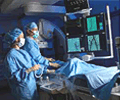Innovation

Canada lags G7 in cost-saving IR procedures
August 6, 2014
TORONTO – Canada lags behind most G7 countries when it comes to the use of Interventional Radiology procedures, and is dead last in several important IR procedures, despite evidence that IR results in lower costs to the healthcare system, faster recoveries for patients and lower complication rates.
The April 2014 study, titled “Interventional Radiology: Global Landscape and Cost Effectiveness,” was conducted by Millennium Research Group. For its part, MRG conducted an analysis of eleven key therapy areas in interventional radiology (IR) to determine the value that IR treatment brings to both patients and the healthcare system.
Additionally, a cost analysis of minimally-invasive IR therapy relative to the surgical alternative was conducted for three therapy areas including: lower extremity peripheral arterial disease (PAD), abdominal aortic aneurysm (AAA) repair, and interventional oncology for hepatocellular carcinoma (HCC).
For example, Canada came in last place in the use of Interventional Radiology for the treatment of lower extremity peripheral arterial disease (PAD). According to the MRG study, IR results in an average length of stay of 1.9 days, compared with 7.1 days for a surgical bypass conducted in an operating room. The cost of the IR procedure is $10,600 compared with $17,400 for the surgical repair. Moreover, the complication rate for IR is less than half of that for surgical treatment of lower extremity PAD.
This pattern of lower costs, LOS and complications repeats itself for other procedures, such as abdominal aortic aneurysm (AAA) repair and interventional oncology for hepatocellular carcinoma (HCC).
Why does IR usage in Canada lag behind that of other G7 countries?
In general, healthcare funding in Canada is allocated as an annual budget to each hospital. This is in contrast to the US and Europe, where a diagnosis-related group (DRG) system is used, which has allowed IR procedures to gain greater traction in these regions.
In a DRG system, hospitals are reimbursed on a diagnostic code or disease-specific basis, regardless of the intervention that is chosen. This provides an incentive to select the most cost-effective treatment for each patient, which in turn leads to increased patient access to care and less strain on the overall healthcare system.
MRG’s analysis has shown that IR procedures lead to many patient-centered cost savings; however the Canadian health care system does not allow hospital administrators to recognize and take advantage of the value and cost effectiveness of IR.
Cost-effective decision-making in Canada is further hindered by the division of the annual budget among different departments. This is a challenge to IR, because IR procedures typically reduce burdens on the OR budget while adding expense to the interventional and diagnostic radiology operating budget. Although the IR expense is typically smaller than the corresponding OR expense, this phenomenon reflects poorly on the annual IR budget.
What does the Millennium report recommend?
Based on the cost-effectiveness conclusions reached in this document, MRG recommends that Canadian governments and hospital administrators revise the system of budget allocation towards IR procedures. Based on the examples of lower extremity PAD and EVAR, government and administration should recognize that increased short-term funding of IR may reduce the long-term burden on the healthcare system by improving patient access to care. This is causing Canada to miss out on opportunities to save money and reduce hospital bed wait times through adoption of cost-effective IR procedures.
Separate funding should be made available for IR procedures that have demonstrated cost-effectiveness relative to their status quo surgical counterparts. This includes minimally invasive lower extremity PAD procedures, EVAR, and radiofrequency (RF) ablation.
It is important that interventional radiologists become more clinical in practice; however there are challenges to the evolution of Canadian IR in this direction. Unfavourable IR remuneration schedules make it challenging for interventional radiologists to participate in clinical evaluation.
Furthermore, IR departments tend to be understaffed, leaving little time for clinical pursuits. Currently, administrators in Canada are reluctant to finance hiring clinical assistants such as nurse practitioners, clinical nurse educators, and assistants to support clinical activities in IR.
Additionally, there is a lack of clinic space and infrastructure in IR for patient consults and follow-up visits. These factors are large contributors to Canada’s lag in IR adoption relative to other G7 countries. An increase in IR resources and staffing is required in order to drive growth in IR while maintaining the caseload of valuable and cost-saving IR procedures such as drainage, vascular access, and GI bleed embolization.
Canadian hospitals should increase IR support staffing, including nurses, technologists, and administrative assistants. Increased support would allow interventional radiologists to better manage the time constraints of adopting an increased clinical role, while allowing IR procedures to expand beyond the current caseload.
More interventional radiologists should be trained and hired to keep up with the current and future demands on the IR departments of Canadian hospitals. This involves increased enrollment in IR fellowships, which can be driven through promotion and raising awareness or the subspecialty to medical schools by the Canadian Interventional Radiology Association, supported by a government-led initiative to increase IR positions in Canada.
The Canadian Interventional Radiology Association should continue to play an active role in the development of IR in Canada. IR-based education, marketing and training should be targeted at general practitioners (GP) and hospital administrators to increase awareness of IR and the value that it brings to Canadian healthcare.
Educational marketing should also be targeted to patients to increase their awareness of IR treatments and the patient benefits associated with these procedures. MRG also recommends that CIRA work with industry to drive awareness, because industry has a stake in many IR procedures, and a greater marketing budget. Canadian patients would benefit from an improved understanding of the minimally-invasive options available to them; this is particularly true for procedures with historically poor referral such as UFE.
Finally, the Canadian Interventional Radiology Association should work with multidisciplinary physician groups to develop best practices that result in the creation of effective referral patterns.
